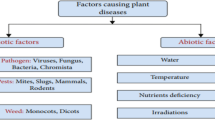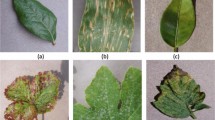Abstract
Plant pathologists desire an accurate and reliable soybean plant disease diagnosis system. In this study, we propose an efficient soybean diseases identification method based on a transfer learning approach by using pretrained AlexNet and GoogleNet convolutional neural networks (CNNs). The proposed AlexNet and GoogleNet CNNs were trained using 649 and 550 image samples of diseased and healthy soybean leaves, respectively, to identify three soybean diseases. We used the five-fold cross-validation strategy. The proposed AlexNet and GoogleNet CNN-based models achieved an accuracy of 98.75% and 96.25%, respectively. This accuracy was considerably higher than that for conventional pattern recognition techniques. The experimental results for the identification of soybean diseases indicated that the proposed model achieved highest efficiency.










Similar content being viewed by others
References
Al-Bashish D, Braik M, Bani-Ahmad S (2011) Detection and classification of leaf diseases using K-means-based segmentation and neural networks based classification. Inform Technol J 10(267–275):2011. https://doi.org/10.3923/itj.2011.267.275
Barbedo JGAB (2016) A review on the main challenges in automatic plant disease identification based on visible range images. Biosys Eng 144:52–60
Barbedo JGA (2013) Digital image processing techniques for detecting, quantifying and classifying plant diseases. SpringerPlus 2(1):660–672
S. Phadikar , J. Sil , Rice disease identification using pattern recognition tech- niques. In: Proceedings of the IEEE International Conference on Computer and Information Technology (ICCIT), Khulna, Bangladesh, 2008, pp 420–423
Asfarian A, Herdiyeni Y, Rauf A, Mutaqin KH (2014) A computer vision for rice disease identification to support integrated pest management. Crop Prot 61:103–104
Khairnar K, Dagade R (2014) Disease detection and diagnosis on plant using image processing—a review. Int J Comput Appl 108(13):36–39
Kim DG, Burks TF, Qin J, Bulanon DM (2009) Classification of grapefruit peel diseases using color texture feature analysis. Int J Agric Biol Eng 2(3):41–50
Tejal Deshpande and K. S. Raghuvanshi (2014) Grading and identification of disease in pomegranate leaf and fruit. (IJCSIT) Int J Comput Sci Inf Technol 5(3): 4638–4645
Chai Y, Wang XD (2013) Recognition of greenhouse tomato disease based on image processing technology. Tech Autom Appl 9:83–89
Zhang LN, Yang B (2014) Research on recognition of maize disease based on mobile internet and support vector machine technique. Trans Tech Publ 108(13):659–662
Al Hiary H, Bani Ahmad S, Reyalat M, Braik M, ALRahamneh Z (2011) Fast and accurate detection and classification of plant diseases. Int J Comput Appl 17:31–38. https://doi.org/10.5120/ijca
Mokhtar U, Hassenian AE, Emary E, Mahmoud MA (2015) SVM-Based detection of tomato leaves diseases. In: Advances in intelligent system and computing. Springer, pp 641–652
Le Cun Y, Bottou L, Bengio Y, et al. (1998) Gradient-based learning applied to document recognition. Proc. IEEE 86(11): 2278–2324
Yanming G, et. al. (2016) Deep learning for visual understanding: a review. Neurocomputing 187: 27–48
Practical Deep Learning Examples with MATLAB (2018) Math Works, Inc., pp 1–33
Yang L et al (2018) Identification of rice diseases using deep convolutional neural networks. Neurocomputing 267:378–384
Brahimi M, Boukhalfa K, Moussaoui A (2017) Deep learning for tomato diseases: classification and symptoms visualization. Appl Artif Intell 31:299–315
Hinton GE (2012) A practical guide to training restricted Boltzmann machines. Mo-Mentum 9(1):599–619
Goodfellow I, Bengio Y, Courville A (2016) Deep learning. MIT Press, pp 1–783
Mohanty SP, Hughes DP, Salathé M (2016) Using deep learning for image-based plant disease detection. Front Plant Sci. https://doi.org/10.3389/fpls.2016.01419
Konstantinos PF (2018) Deep learning models for plant disease detection and diagnosis. Comput Electron Agric 145:311–318
Rangarajan AK, Purushothaman R, Ramesh A (2018) Tomato crop disease classification using pre-trained deep learning algorithm. Procedia Comput Sci 133:1040–1047
Acknowledgements
This work is supported by Dr. V.S.Patil, Plant Pathology, Zonal Agricultural Research Station, Kolhapur under Mahatma Phule Krishi Vidyapeeth, Rahuri, Maharashtra India.
Author information
Authors and Affiliations
Corresponding author
Rights and permissions
About this article
Cite this article
Jadhav, S.B., Udupi, V.R. & Patil, S.B. Identification of plant diseases using convolutional neural networks. Int. j. inf. tecnol. 13, 2461–2470 (2021). https://doi.org/10.1007/s41870-020-00437-5
Received:
Accepted:
Published:
Issue Date:
DOI: https://doi.org/10.1007/s41870-020-00437-5




